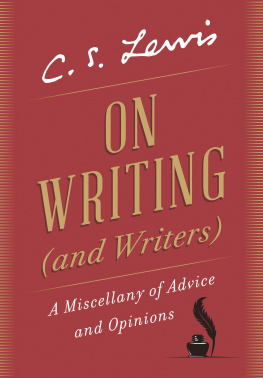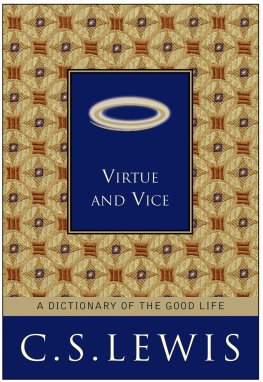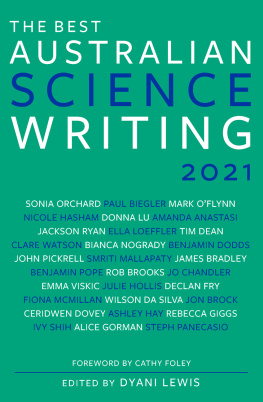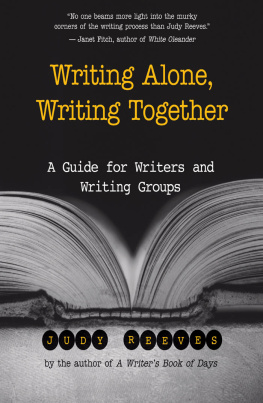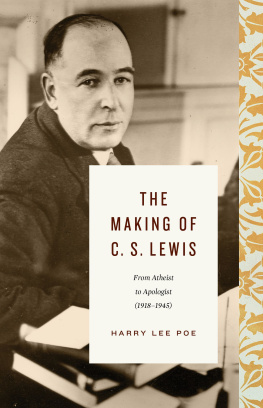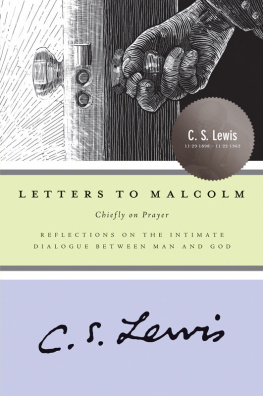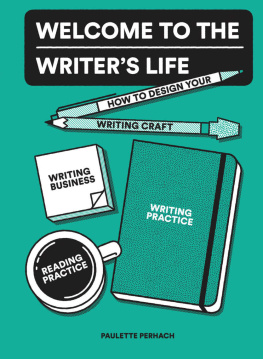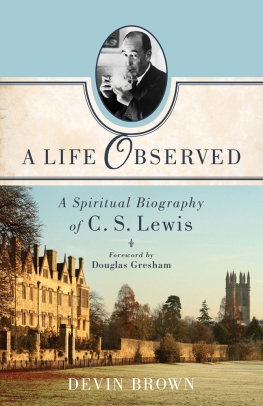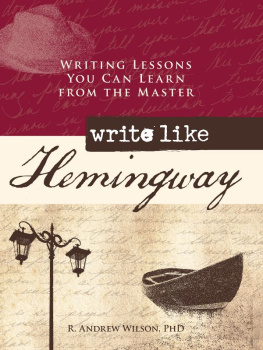C. S. Lewis and the Art of Writing
What the Essayist, Poet, Novelist, Literary Critic, Apologist, Memoirist, Theologian Teaches Us about the Life and Craft of Writing
Corey Latta

C. S. Lewis AND THE ART OF Writing
What the Essayist, Poet, Novelist, Literary Critic, Apologist, Memoirist, Theologian Teaches Us about the Life and Craft of Writing
Copyright 2016 Corey Latta. All rights reserved. Except for brief quotations in critical publications or reviews, no part of this book may be reproduced in any manner without prior written permission from the publisher. Write: Permissions, Wipf and Stock Publishers, W. th Ave., Suite , Eugene, OR 97401 .
Cascade Books
An Imprint of Wipf and Stock Publishers
W. th Ave., Suite
Eugene, OR 97401
www.wipfandstock.com
paperback isbn: 978-1-4982-2534-2
hardcover isbn: 978-1-4982-2536-6
ebook isbn: 978-1-4982-2535-9
Cataloguing-in-Publication data:
Names: Latta, Corey.
Title: C. S. Lewis and the art of writing : what the essayist, poet, novelist, literary critic, apologist, memoirist, theologian teaches us about the life and craft of writing / Corey Latta.
Description: Eugene, OR: Cascade Books, 2016 | Includes bibliographical references and index.
Identifiers: isbn 978-1-4982-2534-2 ( paperback ) | isbn 978-1-4982-2536-6 ( hardcover ) | isbn 978-1-4982-2535-9 ( ebook )
Subjects: LCSH: Lewis, C. S. (Clive Staples), 18981963 Criticism and interpretation | Authorship | Fictiontechnique | Writing | Creative writing
Classification: PR6023 L38 2016 ( paperback ) | PR6023 ( ebook )
Manufactured in the U.S.A. 08/10/16
Photos and excerpts from The Lewis Family Papers used by permission of the Marion E. Wade Center, Wheaton College, Wheaton, IL.
Extracts by C. S. Lewis copyright C. S. Lewis Pte. Ltd.. Reprinted by permission.
Table of Contents
To Jennifer, whose patience is as beautiful a book as Ive ever read.
This most of all: ask yourself in the most silent hour of your night: must I write? Dig into yourself for a deep answer. And if this answer rings out in assent, if you meet this solemn question with a strong, simple I must, then build your life in accordance with this necessity; your whole life, even into its humblest and most indifferent hour, must become a sign and witness to this impulse.
Rainer Maria Rilke, Letters to a Young Poet
Obedience is an unpopular word nowadays, but the artist must be obedient to the work, whether it be a symphony, a painting, or a story for a small child. I believe that each work of art, whether it is a work of great genius or something very small, comes to the artist and says Here I am. Enflesh me. Give birth to me.
Madeleine LEngle, Walking on Water
Acknowledgements
C . S. Lewis and the Art of Writing only exists because of the help of my friends and colleagues. I owe the idea for this book to Dr. Jerry Root and to Dr. Jameela Lares, both exemplary models of scholarship, integrity, and faith. Im particularly thankful for the wonderful services of the staff at the Wade Center and for Marjorie Lamp Mead. Im also indebted to the inestimable editorial work of Marybeth Davis Baggett.
Ink to Cure All Human Ills
Whenever you are fed up with life, start writing: ink is the great cure for all human ills, as I have found out long ago.
Lewis, to Arthur Greeves
R eaders know C. S. Lewis from his fantasy works, meeting the prolific author in the icy woods of Narnia, on the high vast plains of The Great Divorce , or on the paradisal seas of Perelandra. Just as many, if not more, know Lewis from his immensely influential apologetic works, each filled with eminently quotable passages. Jesus must either be liar, lunatic, or Lord ; Pain is Gods megaphone to rouse a deaf world ; Next to the Blessed Sacrament itself, your neighbor is the holiest object presented to your senses provide memorable paths of familiarity to Lewis the theological thinker. Some know Lewis primarily from his professional scholarship as a prominent literature scholar, whose expertise in Medieval and Renaissance studies as well as literary theory produced contributions such as The Discarded Image , An Experiment in Criticism , and English Literature in the Sixteenth Century .
Despite Lewiss fame in several fields and his library of publications, very few, Id wager, when they think of Lewis, consider him a writers writer, a craftsman of English prose whose content proves inseverable from his lessons on how to write. C. S. Lewis and the Art of Writing means to meet Lewis on the field of composition and to acquaint Lewiss devotees with his identity as a master of the English language, a writer whose capacity for clarity, precision, and exemplary execution is matched only by the quality of his thinking.
The reasons for this book are simple. First, to date, no one has taken on the task of writing about Lewiss philosophy, style, and craft of writing. Its worth knowing that Lewis never intended to be a famous theologian or bestselling fantasy novelist, as his preeminence in those areas may lead some to believe. He did, however, from a very early age want to be a writera poet, to be precise. Writerly desire, not unlike those early visitations of joyous yearning ( Sehnsucht ) he wrote about in Surprised by Joy , enduringly animated Lewiss early life. From his childhood world of Boxen , through his pre-Christian works of poetry S pirits in Bondage and Dymer , to the myriad of his post-conversion writings, fiction and non, Lewis demonstrated a tremendous affinity and capacity for clear, functional, and beautiful language. The dearth of work on Lewiss writing as writing is surprising. But dearth is opportunity. And Lewiss life and works are far from overdone as objects of study. If we with an interest in Lewiseither scholarly or amateurare to deepen our knowledge of and affection for the great writer, then we must spend more time considering the life of his craft.
A second reason for this book is to pay homage to Lewis. No other prose writer, living or dead, has influenced me more in terms of style. Years of pouring over Lewiss work, both for pleasure and academic purposes, have indelibly impressed upon me the importance of effective language to conveyor omnibus, if you likeprofound ideas. A watershed moment in my writing life came when my dissertation advisor, an accomplished Milton scholar, Anglophile, and avid Lewis lover, challenged my view of Lewis and called my craft to a higher plane. My dissertation analyzed C. S. Lewis, T. S. Eliot, and W. H. Audens theology of time, as influenced, I argued, by French Philosopher Henri Bergsons theory of duration. In the fray of revisions, after submitting a relatively rough portion of the chapter on Lewis, my advisor said, Youre writing about one of the most clear and articulate writers of the twentieth century, so you had better write about him in a worthy manner.
She was right. I had better. And I did. When I began to pay close attention to the way Lewis wrote, I appreciated what he wrote about all the more. His writing not only transmits his ideas, it vivifies them. The danger of self-protection in The Four Loves finds its force in the alliterative cadence of Lewiss syntax, when he warns that the invulnerable heart will become unbreakable, impenetrable, irredeemable. Its Lewis mastery of the asylumed image that makes an otherwise obvious idea so forcible: A man can no more diminish Gods glory by refusing to worship Him than a lunatic can put out the sun by scribbling the word darkness on the walls of his cell. Again, Aim at heaven and you will get Earth thrown in: aim at Earth and you will get neither, which Lewis writes in Mere Christianity , is a profound truth, one on which Ive tried to center my life. But the power of this proposition, what actually deploys this Matthean idea (Matt :), is its functional diction, its symmetrical rhythm, its play on verb tense, its simple clarity.


